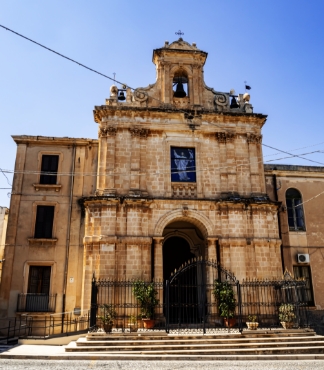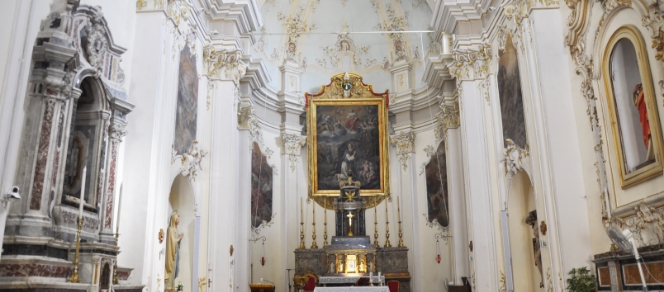Church of Saint Anthony the Abbott
1702-1703; facade 1798-1799
Open every day 8-12/17-21
Telefono: 0931/831312
The Church of Saint Anthony the Abbott in the Troncello district located in the lower part of the old city was recorded from as early as 1498. From 1612 the church housed the wooden statue of Christ at the Column, which was taken on processions during Holy Week. Having been unharmed by the earthquake of 1693 it was then the object of donations from the survivors. In 1702 sale of the donated gold allowed the church to be rebuilt in the new city in its six-sided layout with right-angled roads.
The building was inaugurated in 1703 and stands on the northern side of the historic centre of the new city, overlooking the square named after S. Antonio Abate (now Piazza Regina Elena). It also gave its name to one of the four districts that made up the new city. The main altar features a large painting of Saint Anthony dated 1713, which was donated by the Cannamilari, the sugar cane workers that were active in Avola from the fifteenth century up until the early nineteenth century. An altar in the baroque style made from precious polychrome marble was commissioned in Catania in 1773 from the magister Matteo Bonaventura as the setting for the statue of Christ at the Column.
The church was decorated in rococo style stucco work attributed to Giovanni Barbiera of Palermo. It was executed with sophisticated workmanship, and it is known that it was carried out in 1774-1775.


On the vault inside ovals surrounded by ornate stucco work there are paintings with excellent composition and use of colour in tempera on “dry” plaster attributed to the artist Ermenegildo Martorana of Palermo (C. Siracusano). The paintings represent the allegories of Charity and Faith and, in the central position, the Glory of Mary with the saints Teresa of Ávila and Augustine. The paintings on the church walls depicting the Doctors of the Church and the four Evangelists are also attributed to Martorana. On the wall to the left of the nave are paintings of Saint Augustine and Saint Gregory the Great, and on the wall to the right are Saint Jerome and Saint Ambrose. The semi-circular wall of the apse conch has paintings of the evangelists Matthew, Mark, Luke and John.


In 1798-1799 the church façade was rebuilt to designs by Corrado Mazza, caput magistrorum of Noto. The rebuild included a pronaos flanked by four columns with Egyptian-style capitals with lotus leaf motifs. The magnificent main altar in precious onyx is neo-classical in style and also has Egyptian motifs. In 1839 the organ built by the Platania brothers at Acireale was installed on the inner wall of the façade over the chancel.
The “Holy Friday” procession with the Mysteries and the Dead Christ known as the procession of the holy thorn is linked to the church. The earliest recording of the event dates back to 1707. It was organised by doctor of law Sebastiano Xenia with statues made in Avola by Francesco Guarino, and the contribution “of all of the People”. The College of Mary was adjacent to the church. Founded in 1791 by Clara Morale Sodaro (†1797) it became fully operational in 1803 with its bequests and helped to promote girls’ education in the city.
Explore the historic center of Avola!
Welcome to Avola, the hexagonal city! Explore the historic center.
Explore the historic center of Avola!
Welcome to Avola, the hexagonal city! Explore the historic center.
